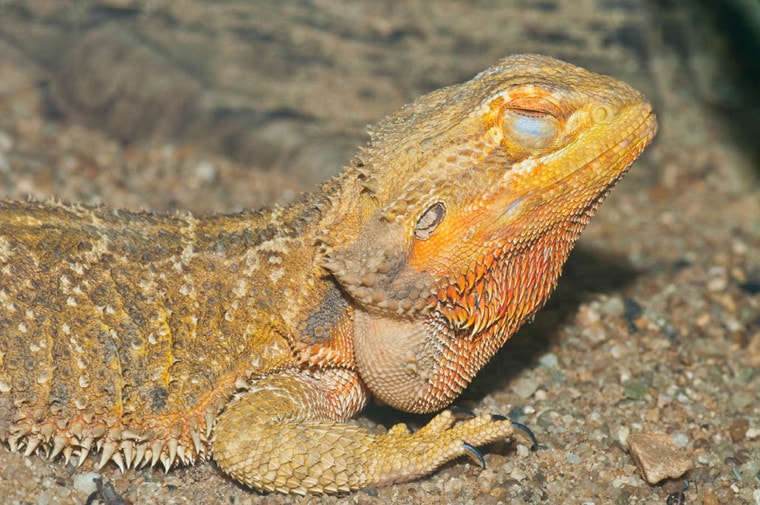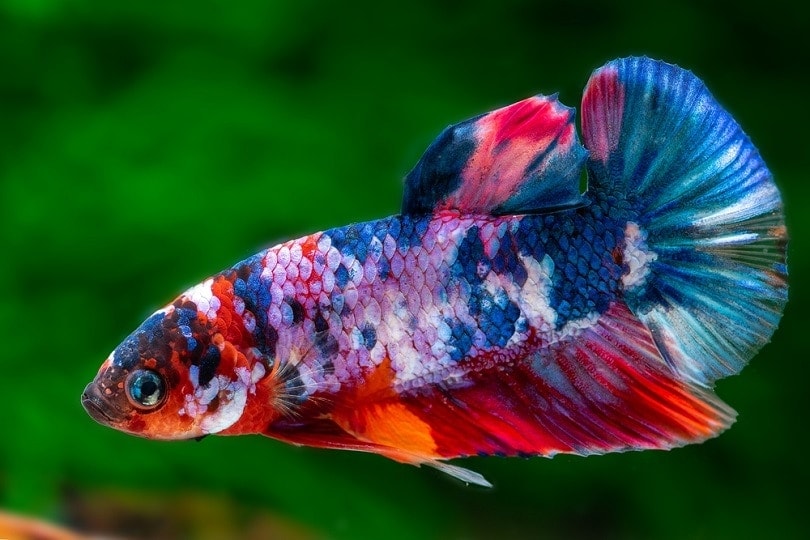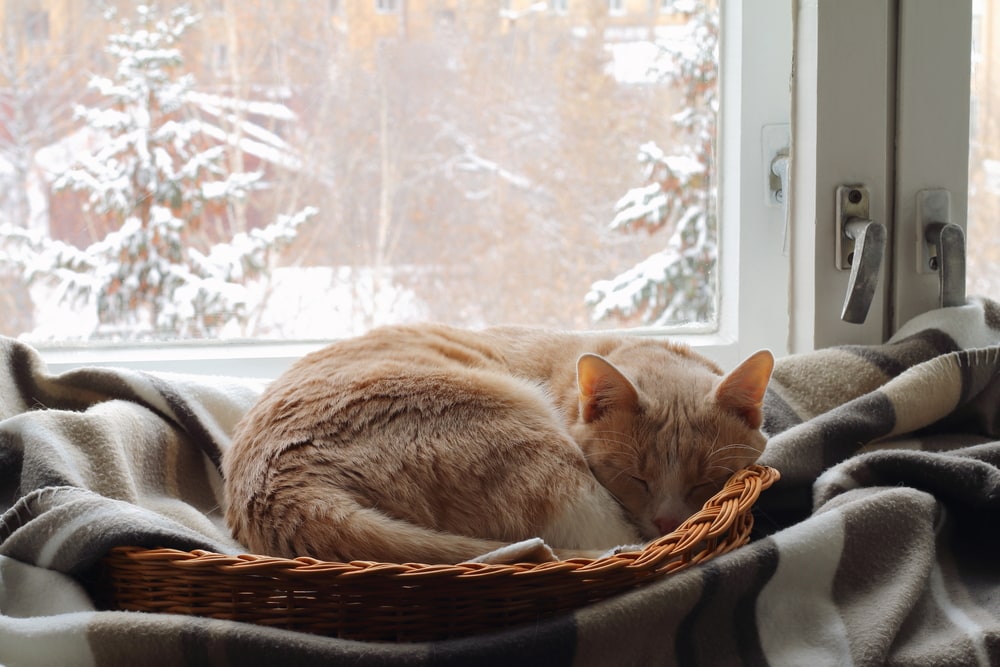
Brumation is the formal term for the hibernation state that bearded dragons will enter into, typically during colder months.
We are taught about hibernation from a young age, but we typically associate the behavior more with mammals like bears than with scaly lizards. However, cold-blooded animals typically experience their own versions of hibernation called brumation.
Lizards and other cold-blooded animals will not always partake in this innate activity when kept in captivity. The possibility of brumation and what you should do while it happens is still a good thing to be aware of when you own a lizard. The alternative is thinking that they are sick, dead, or dying and treating them improperly during a sensitive period of their lives
This article covers everything that you need to know about your bearded dragons and brumation, including signs and symptoms, what to expect during and after, and how you should care for the dragon during brumation.
What Is Bearded Dragon Brumation?
Brumation is cold-blooded animals’ version of hibernation. It is a natural process that they may or may not partake in while in captivity. However, you should expect it because it is an intrinsic part of their survival techniques in the wild.
Your bearded dragon may enter into brumation as millions of generations of lizards have done before it. It is common even among lizards whose predecessors have been bred in captivity for multiple decades.

Why Do Bearded Dragons Brumate?
Among other lizards, bearded dragons brumate as a survival response to living in Central Australia in the middle of the desert. Even deserts experience seasonal change, especially on a lower latitude line.
There will be less plant and insect life available for your bearded dragon to eat during the winter months. Their coping mechanism is to construct a burrow, dig themselves into it, and sleep through this challenging time of the year. Before doing so, they build up their internal reserves, and their body lives off this as they sleep.
It is worth noting that Australia is in the southern hemisphere, and they experience winter in the months from June to August. Do not be surprised if your lizard “misses” winter and begins brumating in late May.
Signs of Brumation
Brumation can look similar to certain illnesses that your dragon could fall prey to, but there are quite a few signs that they are brumating and not feeling ill.
A bearded dragon that feels the call of the wild to take a long nap will want to cut their food intake. They will refuse to eat anything or keep it minimal. If that is paired with exponentially more hours spent sleeping, then you probably have a brumating dragon on your hands.
It is still a good idea to get a fecal test done for them at your veterinary office, though. These signs can be similar to those associated with parasite load and other damaging illnesses. Play it safe, and do not assume that you know exactly what is going on.

Length and Timing of Brumation
Your bearded dragon is not in danger of dying from a lack of food or water when they are kept in captivity. You feed them consistently and make sure they have water. They no longer have to rely on Mother Nature to care for them.
However, your dragon doesn’t know this nor do their genetics.
Since they might adjust somewhat to life in captivity, their brumation length is not as reliable as it is in the wild.
A bearded dragon can brumate for anywhere from a couple of weeks to four months, as they would in nature. Have patience, and give them as long as they need. Fighting their instincts will only confuse them and could even lead to sickness.
What to Do During Brumation
When your bearded dragon brumates, it isn’t a sign that you get to take a step back from their care until they are walking around again.
There are certain things that a responsible owner should do to ensure that the process goes smoothly for both you and your dragon. First, get that fecal test done so you know how to take care of your dragon in the way that they need.
After you get the all-clear from the vet, there are two main categories to keep track of: the heat and light in their enclosure and the food and water that you give them. Essentially, you are trying to partner with them to simulate winter and their natural habitat as much as possible. Once they begin to brumate full time, continue to check on them every day.
Heat and Light
When you begin to notice the signs that your bearded dragon wants to brumate, reduce their heating each day over the next couple of weeks, as would happen in the wild. You can get right up to the point where there is not any heating on at all.
Start doing this by reducing their basking hours. You can also use a lower-watt bulb to keep the temperatures and light lower during the day. Keep the temperatures low like this until your dragon starts moving around again. Then, slowly increase their heat and light every day.
You can entirely turn off the heat and UVB lights at the end of the transition process. In the wild, the dragon would be in a burrow covered with dirt. No light would be getting in, and the shelter would stay continuously cool.
If you have your lizard in a room where you will need to turn lights on, you can cover their enclosure with paper or a thin blanket. Just make sure they can still breathe freely on the inside.
Food and Water
Once your dragon begins to brumate fully, you should completely stop trying to feed them. They would stay secluded in their burrows for many weeks and wouldn’t eat anything during that time, so it is 100% natural.
However, if your dragon has a full belly that they might sleep on for weeks, the food will begin to rot inside of them. That is why they naturally avoid food before they start to brumate, and you should respect those signs and not try to feed them beforehand.
If the food does start to rot inside them, they can experience life-threatening issues and will need to be rushed to the vet once they wake up, as they will be very sick.
Watering them during their brumation process is only slightly necessary. You should already have a small water bowl in their enclosure. The most that you should do is place it somewhat closer to them while they sleep, so if they wake for limited periods, it is easy for them to reach without moving much. Refresh it every week.

What to Expect During Brumation
Weight loss of three to four grams is average for a healthy bearded dragon. They don’t lose much weight because their bodies are functioning on a much lower level than usual. If you notice substantial weight loss, an illness or parasite could be the cause, and they will need to visit the vet.
To monitor their weight, weigh them one or two times a week. As long as you do this efficiently, you should barely bother them from their sweet dreams.
Although you can’t see it happening, researchers have found that hormonal changes occur in the dragon while they sleep. The cool temperatures positively affect sperm production in males. The introduction of warmer temperatures after waking also aids a female’s ovulation.
So, if you breed bearded dragons, brumation is vital for optimal reproduction.
What to Do for Bearded Dragons After Brumation
Weeks and weeks of caring for a sleeping creature can turn into a relaxing routine, but one day, when you check on them, they will be looking back at you or skittering around their enclosure.
Start their waking hours by bathing them. It also creates an opportunity for drink stimulation. Turn everything back on again gradually, and give them more food each day until they are back to their normal amount. They most likely won’t eat much at first, but that is natural.
Once they do begin to eat normally, they will have a voracious appetite. Ensure that what you give them is still balanced, and mix in healthy greens and hydration opportunities.
If they come out of brumation and are still happy and healthy, you know that you have succeeded in the role of Mother Nature. Brumation is now another factor of being a lizard owner that you can check off the experience list.
Final Thoughts
Brumation is such an interesting process! We hope this article sheds some light on brumation and your bearded dragon. Let us know about your brumation experience with your bearded dragon in the comments.
Featured Image Credit: KobchaiMa, Shutterstock










